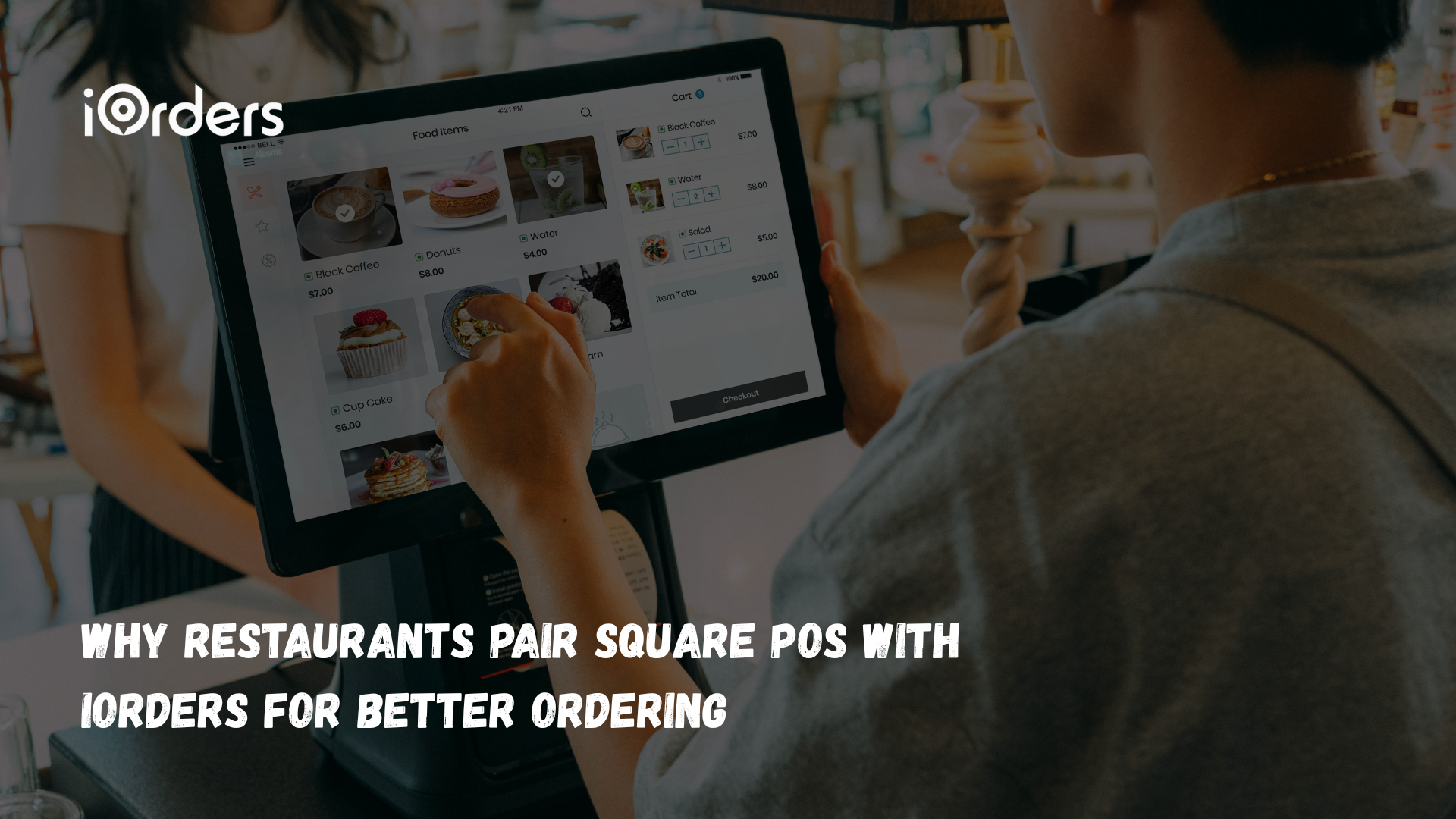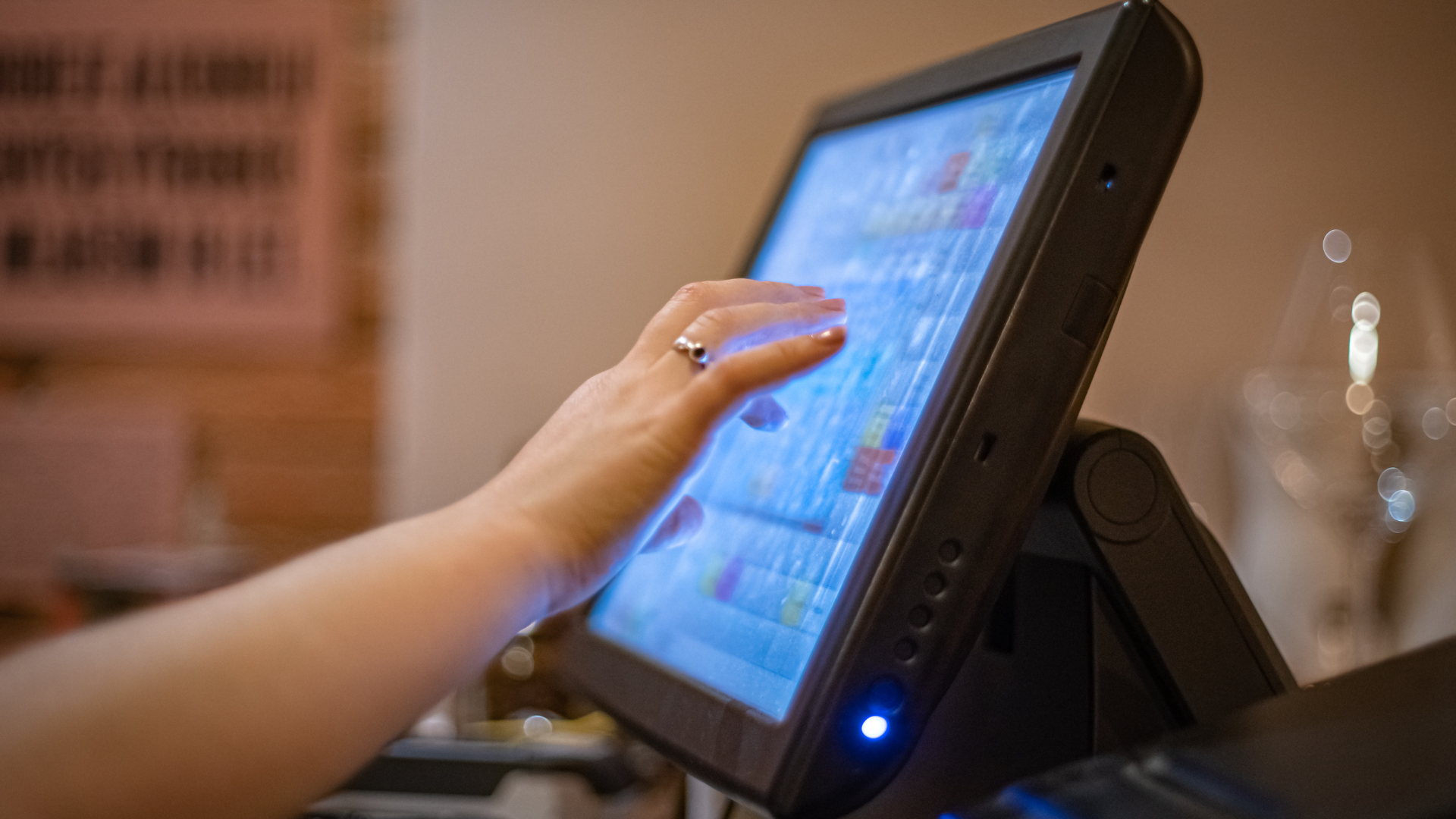November 19, 2025

Running a restaurant on Square POS is easy until the rush hits. A busy Saturday evening is a perfect example. With Square alone, your staff is juggling manual order entry, kitchen tickets piling up on a single printer, and customers refreshing a generic ordering page to see if their order went through.
Now imagine the same scene with Square POS + iOrders. Online orders route automatically to the right kitchen station, your branded ordering page updates in real time, and the kitchen display system shows every ticket with prep timers. Customers get faster service, your team stays in sync, and operations feel calm even when the orders don’t stop.
That’s why so many restaurants pair Square’s simplicity with iOrders’ advanced restaurant workflows. Together, they create a complete system that handles ordering, kitchen coordination, and scaling.
At a Glance:

Square POS is a cloud-based point-of-sale system built to help F&B businesses manage everyday operations, including payments, orders, menus, and basic customer interactions from a single platform.
Today, it has become one of the most trusted POS choices for cafes, food trucks, QSRs, and small restaurants because it prioritizes speed, simplicity, and accessibility.
Here’s why Square POS continues to matter in 2025:
In short, Square POS offers a strong operational backbone for modern F&B businesses. But as restaurants expand to multiple locations, add kiosk ordering, streamline kitchen operations, or want tighter control over online ordering and delivery, they often integrate with platforms like iOrders to unlock advanced efficiency and automation beyond Square’s native capabilities.
Also Read: Top Food Trends for 2025 You Need to Know

Square POS covers the fundamentals extremely well, but growing restaurants, especially multi-station, multi-location, or high-volume kitchens, often encounter operational needs that go beyond basic POS capabilities.
As menus, workflows, and order volumes become more complex, businesses start looking for additional tools to keep everything running smoothly.
Here are the areas where restaurants typically need more than Square alone:
1. Advanced menu structures and customizations: Restaurants offering combos, half-and-half items, nested modifiers, or cuisine-specific customizations (e.g., spice levels, topping sets, portion sizes) often outgrow Square’s standard menu logic.
They need a system that can accurately map every customization to the kitchen without slowing down ordering.
2. High-volume kitchens requiring dynamic order routing: During peak hours, kitchens depend on intelligent routing, sending orders automatically to the right prep stations (grill, fryer, dessert, drinks, etc.).
Without this, staff must manually coordinate tickets, increasing delays and errors.
3. Multiple stations and synchronized KDS workflows: Modern restaurants often run several KDS screens simultaneously. They need real-time updates across all stations, bump-once logic, course sequencing, and clear visibility into prep times.
Square’s basic KDS works for smaller setups, but busy operations require deeper control.
4. Branded online ordering with upsells and personalization: Restaurants want their own ordering website or app with branded UI, dynamic upsells (“add fries?”, “upgrade your drink?”), recommended combos, customer data capture, and loyalty flows, not just a standardized ordering page.
5. Ingredient-level inventory tracking and recipe management: As menus expand, restaurants need to track ingredient consumption per item, monitor depletion in real time, and get alerts before stockouts, especially for high-cost ingredients. Basic item-level tracking isn’t enough.
6. Deeper operational analytics and insights: Growing restaurants need insights into prep time, kitchen delays, menu performance, staff productivity, fulfillment bottlenecks, and multi-location comparisons.
Square’s reports are good for daily summaries, but not for operational optimization.
7. Scaling across multiple locations without friction: When restaurants expand, they need centralized menu management, unified reporting, synchronized KDS standards, and consistent workflows.
Managing these across locations can become challenging without a more specialized operational system integrated into the POS.
These gaps don’t mean Square is lacking; it simply means that as restaurants grow, they need more specialized infrastructure.
Also Read: Best Restaurant Reservation Apps and Systems for 2025

As restaurants grow, basic POS functionality can quickly reach its limits. While Square POS provides a solid foundation for payments, menu setup, and small-scale operations, modern restaurants need more advanced tools to manage complex menus, high-volume kitchens, and multi-channel ordering.
Integrating a restaurant management layer with Square helps bridge this gap, allowing businesses to scale efficiently while maintaining operational control.
Here are some key reasons for upgrading Square POS:
Upgrading Square POS with an integrated restaurant management layer allows businesses to retain the simplicity and reliability of their existing system while adding the operational depth needed to grow, serve customers efficiently, and maximize profitability.
Also Read: 21 Examples of Good Customer Service in a Restaurant

Efficiency and seamless service are key for restaurants. Instead of switching POS systems, restaurants can enhance their existing Square setup with a restaurant management layer.
This adds advanced features like real-time kitchen routing, inventory tracking, branded online ordering, and analytics without retraining staff or investing in new hardware:
Implementing the integration is straightforward and can typically be done in a few key steps:
1. Connect your Square account: Authorize iOrders to access and sync orders, menus, inventory, and modifiers.
2. Import and map menus: Ensure all items, combos, and customizations in Square are accurately reflected in iOrders’ online and offline channels.
3. Set up kitchen workflows: Configure routing rules, batching, and station-level assignments in iOrders so orders flow seamlessly to Square-connected KDS.
4. Configure online ordering channels: Launch branded web, mobile, and QR ordering pages through iOrders, fully synced with your Square POS.
5. Test and optimize: Run sample orders to confirm synchronization, adjust inventory alerts, and refine analytics dashboards.
6. Go live: Begin fully integrated operations, allowing staff to leverage enhanced features while maintaining familiarity with Square’s POS interface.
Integrating Square with a restaurant-focused management layer enhances operational efficiency, keeps costs low, and preserves the familiarity of a trusted POS, allowing restaurants to scale without switching systems.
Enhancing your Square POS with iOrders takes your restaurant operations to the next level. It equips your business with smarter workflows, streamlined ordering, and actionable insights, helping you run a more efficient, profitable, and scalable operation.
Here’s what it delivers:
With iOrders integrated into Square POS, restaurants gain operational precision, better customer experiences, and scalable growth, without the cost, complexity, or learning curve of switching to a new POS system.
Also Read: What Makes a Restaurant Successful: 10 Must-Know Factors and Tips
In 2025, managing multiple locations, complex menus, and online orders can quickly become overwhelming without the right tools. This is where integrating with iOrders transforms your existing POS into a complete restaurant management system.
With seamless order syncing, branded online ordering, advanced kitchen workflows, real-time inventory updates, and actionable analytics, restaurants can streamline operations, reduce errors, and scale efficiently, all while keeping the familiarity and affordability of Square.
Experience the difference for yourself! Book a free demo to see how the iOrders integration can optimize your operations, enhance customer satisfaction, and future-proof your restaurant.
Most users connect Square POS to online stores using official or third-party apps that sync inventory, payments, and catalog data, but setup may require API credentials and some manual configuration for real-time updates.
Yes, integration tools now allow Square POS to aggregate delivery app orders on one tablet or register, streamlining processing and reporting for restaurants and retailers.
Square POS supports a wide range of cash drawers, receipt printers, barcode scanners, tablets, and card readers. Always consult compatibility lists and test devices with the current Square firmware before buying to avoid connection issues.
Users often fix issues by restarting devices, force-quitting and reinstalling the app, performing factory resets, checking Wi-Fi strength, and ensuring all software is updated to the latest version.
Square’s API connects POS sales and transaction data directly to platforms like Xero and QuickBooks, automating daily reports, tax filings, and financial reconciliations to minimize manual work.
Square POS natively processes only Square payments; third-party gateways are unsupported, and cross-border card payments are generally unavailable, which can affect global sellers.
Yes, developers can use Square Terminal API and App Marketplace add-ons to tailor POS functions for retail, restaurants, or service providers, enabling barcode checkout, multi-location support, and specialized reporting.